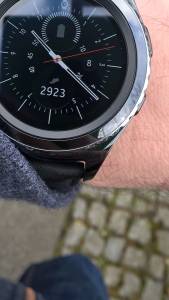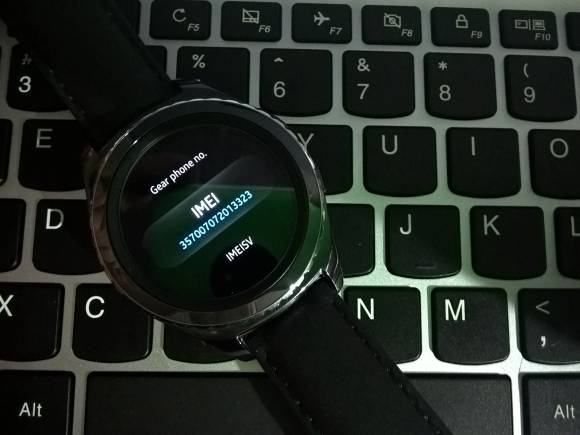When it comes to ultra mobile PCs you can’t get more mobile than a smartwatch. I’ve tracked the technology for years and over the last six months I’ve given three very different smartwatches a long-term test. I’ve recently been using the Samsung Gear S2 Classic 3G eSIM model and it’s an impressive bit of kit. GPS, WiFi, 3G, Bluetooth and an operating system that’s controlled with touch and voice. I’ve also been using a fitness-focused band from Medisana and the Basis Peak which sits somewhere in the middle between a smartwatch and a fitness band. I’ve learned about what I need, what people need and have now some thoughts about the future of smartwatches.

Medisana.
The ViFit activity tracker is simple and low-cost. It’s part of a range of integrated ‘cloud connected’ health devices and does an interesting job at data gathering and data analysis. The battery life is relatively good at 4-5 days. Unfortunately you really need to be using the scales, blood pressure monitor and blood sugar level monitor to get the best out of it and interpreting the data is probably best left to a specialist. My wife, a business health adviser, would get more out of the system than I do and that’s why I don’t use it anymore, despite it costing under $50. [On loan from Medisana.]
 Basis Peak.
Basis Peak.
The Basis Peak watch is a hybrid health and smartwatch. It gives you continuous pulse rate monitoring, automatic activity tracking (it works out when I’m sleeping, walking or cycling without me having to configure anything) and integrates over Bluetooth LE for smartphone-initiated notifications. Data analysis is presented, as on the Medisana ViFit, on a website and I found it to be easy to use. Battery life is 3-4 days and that is mainly because this isn’t a screen-focused device. It’s not expensive (around $130) and for me it really hits the right balance of features. I cycle and walk a fair bit so maybe that’s one of the reasons but battery life and simplicity play an important role too. The problem is that it’s incredibly ugly and that’s why I’m not wearing it a lot. [On loan from Intel.]
 Samsung Gear S2 Classic 3G.
Samsung Gear S2 Classic 3G.
If you’re interested in electronic gadgets then there isn’t much more exciting than this. Like the Nokia Internet Tablet 770 of 2006 it stimulates one to think of different use cases and to think about what could happen in the future. It is useful too!
After you’ve taken the time to learn the UI and configure the notifications it’s an informative device. It looks good and feels good.
Battery life is pathetic. In some cases I’ve run out of battery before getting home from work and in every case apart from ‘airplane’ mode you’ll need to charge at night. It charges relatively quickly and the charging stand is easy to use but hey, once a fricking day? Please. Despite the battery life issue I’m wearing the Gear S2 most days and I don’t even use a compatible smartphone, don’t enable the WiFi and haven’t configured the eSIM 3G (phone) function. [On loan from Vodafone Germany.]
My favorite smartwatch.
Three different devices with three different target markets. I’ve learned a lot from them and have taken on the Gear S2 3G as my buddy although note that it’s an expensive, cool, feature-rich and good-looking watch that I didn’t pay for. I have a big desire to learn more about the WiFi and 3G features and will start to carry an Android smartphone to get the best out of it. The ViFit is a tracker that’s part of a larger ecosystem and I’m personally not health-focused enough, nor am I forced, to get the best out of it.
The Basis Peak has the ‘just right’ feature set, battery life and simplicity that I need in a smartwatch. I don’t want to manage a set of 20 notification permissions and nor do I want to make calls with it or talk to it. I’m a little scared of the privacy issues an advanced smartphone too so the Basis Peak is perfect. The only problem is that it’s an ugly beast of a watch and I don’t want it on my wrist which is why I’m using the Gear S2 in a basis setup.
Your favorite smartwatch.
There’s no doubt that the Gear S2 Classic 3G is amazing and if you were given one to test you’d probably get excited about it. You probably won’t though so you’ll have to think about spending 370 Euro for it. Damn that’s a lot of money for a product that’s going to be out of date in 18 months. Unless you’re researching the smartwatch scene or have a particular use case that gives you justification then you’re not going to buy the Gear S2 Classic 3G. 300 Euro for the non 3G version is expensive too.
At $130 / 199 Euro (strangely expensive pricing in Europe) the Basis Peak has the right balance of features, data analysis, connectivity and price for most people but it’s ugly so you won’t buy it either.
None of the above phones suits many people.
 What I learnt about smartwatches.
What I learnt about smartwatches.
This is the important part. I’ve briefly tested a few Android Wear watches over the last 6 months and these three watches got a good long-term test. Here’s what I know.
- I get stimulated by the high-end feature-rich watches. But I wouldn’t commit to spending $300 on one.
- $150 is my pain-point for a smartwatch.
- I’m not good at managing notifications.
- I don’t like charging a watch every night. 3-4 days gives me flexibility. I’d be happy with that.
- Despite not liking once-per-day charging, one smartwatch was interesting enough for me to want to charge it ready for the next day.
- I hate talking to watches (and phones) and I don’t like the privacy aspect of it.
- I want continuous, automatic activity tracking.
- I want GPS and height information on my activity tracking because I cycle a lot and live on a hill.
- I want notifications, but only for calls, alarms, SMS and maybe WhatsApp. At least for now.
- I want my watch to connect with my Windows laptop. It should be the ‘padlock’ device and should sync activity data to the cloud when it can. It should update weather, emails and news.
- I want some style in my smartwatch. We all do. It’s a basic requirement.
- I’m nowhere near using my watch as a wallet. (I live in Germany. It’s a slow process here.)
Remember the 20% rule.
In every year I’ve been tracking ultra mobile PCs the performance and battery life has gone up by 20%. Volume (total size) of the product falls by 20% as does the price. Features improve with every iteration. The same will apply to smartwatches.
At a 20% improvement rate the smart-watch market should meet my mainstream expectations in about 2 years and about a year after that (prices under $100) we’ll be talking about a mainstream smartwatch market.
The Future of smartwatches.
Here’s a list of smartphone trends we’ll see over the next 5 years.
- Improved voice control accuracy and usage
- Standalone capabilities (WiFi, eSIM, unpaired with smartphone)
- Miracast support for large screen usage and projection
- Laptop integration for productivity with keyboard
- Cellular data
- Health data trust. (Share data with insurance companies for tailored insurance packages that will be marketed as discounts.)
- Employee watches focused on health and security (Enjoy the ‘tracking’ discussion when this happens.)
- Childrens watches focused on security
- Camera integration
- Much, much lower price
- Huge ‘brand’ involvement
- Large numbers of cheap, mostly useless products
- Big push for home automation integration
- Watches banned from school classrooms and exams.
Ambient Energy might start to play a part in helping smartwatches go for longer, without charging. Solar, heat, sound and movement energy harvesting is an exciting area for smartwatches and wearables. Intel thinks we’ll reach mW of harvested power which doesn’t sound much but could be enough to power voice response, BT LE sync and an e-ink display.
Finally there’s the subject of smartphone replacement. Smartphone manufacturers need to position themselves carefully here because within 5 years the smartwatch could do enough to keep most customers happy and connected. Young people with sharp eyes may accept small screens. Voice controlled messaging could bring new social networking experiences. I’ll be testing the Gear S2 Classic 3G in this very scenario soon. The battery life will be terrible but it will be an interesting test for someone who doesn’t use a phone for much more than news and messaging and it’s interesting to think of the role that an incredibly thin netbook-style 9-10 inch 2-in-1 could play here. Could a smartwatch and a powerful 10-inch tablet 2-in-1 be everything that mainstream users need?
Again, please note that all three test devices were provided for free as long-term loan devices.












Interesting analysis. Thanks. I’ve tried a number of different devices including Sony Smartwatch, Garmin Vivosmart and Jawbone UP3. Always end up going back to the Basis Peak which does everything I want with a minimum of fuss. I prefer the simple utilitarian appearance over gadgets which also want to look fashionable.
Which color combination do you have? I suspect the black/black combo might be better than my silver/white version.
Yes mine is black with a black strap. Having looked online at the silver and white version I can see your point – rather garish!
Win your own brand new smartwatch and much more IN SOCIALSTOCK CONTEST. SIGN UP HERE: http://www.templatemonster.com/social/
I’ve been Sony Smartwatch 1 user for 3 years, and for me, the future of smartwatch is :
– blind-folded usage
– conveniently positioned input/output proxy for big muscle processors from smartphone or pocket-NUCs
– modularity, for separation of aesthetics element at least (eg. Next gen smartwatch core still fits into the diamond encrusted bezel), if not for additional functional electronics.
Tried a lot of smart watches, worked with tech coworkers who tried a lot more – after I tried a plain old black and white pebble, it just made so much goddamn sense.
Why would I want to charge some fancy thing with a tiny screen every day? Then it can’t wake me up, or do any cool stuff.
Pebble started pretty humble. I have a pebble time now, and just a few colors does add contrast without adding crazy complications. I don’t use my smartwatch to look at pictures, I use it to help get me up gently and quietly in between REM cycles, to control music while I bike and drive and at work, and to get me to meetings, appointments on time. It does this with 10 day battery life.
My first pebble was purchased used, old, and took a beating kayaking – the screen started to get the black lines. I was annoyed, but contacted pebble anyhow. All they needed was a picture of it and the serial number and bam, new pebble, 100% waterproof guarantee up to 30 meters. Not resistant, proof. I still keep that old one in a tin, as a backup.
My Pebble time has gone diving, swimming, stays on 24/7, and just doesn’t have issues. My samsung smartwatches, that microsoft thing, and my xiomi fitness thing, I don’t know where those are. Those were awful. I don’t want a touchscreen on my wrist, I was long battery life and a clean, readable simple screen.
You should try a pebble, chippy – For me it was the most practical revelation in smartwatches – it doesn’t try to reinvent the wheel, it just does what you’d want.